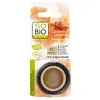What's inside
What's inside
 Key Ingredients
Key Ingredients

 Benefits
Benefits

 Concerns
Concerns

 Ingredients Side-by-side
Ingredients Side-by-side

Water
Skin ConditioningCetearyl Alcohol
EmollientCetyl Esters
EmollientBehentrimonium Chloride
PreservativeTriheptanoin
Skin ConditioningHydrogenated Ethylhexyl Olivate
EmollientOlea Europaea Fruit Oil
MaskingGlycerin
HumectantJojoba Esters
EmollientCetyl Alcohol
EmollientPropanediol
SolventParfum
MaskingHelianthus Annuus Seed Wax
Skin ConditioningHydrogenated Olive Oil Unsaponifiables
EmollientPanthenol
Skin ConditioningLepidium Sativum Sprout Extract
Skin ConditioningOpuntia Ficus-Indica Stem Extract
Skin ConditioningLeontopodium Alpinum Extract
Skin ConditioningCaesalpinia Spinosa Fruit Extract
Skin ProtectingOryza Sativa Seed Protein
AntioxidantOryza Sativa Bran Extract
Skin ConditioningOryza Sativa Extract
AbsorbentHelianthus Annuus Sprout Extract
Skin ConditioningHelianthus Annuus Extract
EmollientRosmarinus Officinalis Leaf Extract
AntimicrobialGuar Hydroxypropyltrimonium Chloride
Skin ConditioningPolyglycerin-3
HumectantCetrimonium Chloride
AntimicrobialTocopherol
AntioxidantMaltodextrin
AbsorbentCalcium Gluconate
HumectantGluconolactone
Skin ConditioningSodium Phytate
Phytic Acid
Potassium Sorbate
PreservativeSorbic Acid
PreservativeSodium Benzoate
MaskingBenzoic Acid
MaskingEthylhexylglycerin
Skin ConditioningCaprylyl Glycol
EmollientChlorphenesin
AntimicrobialLecithin
EmollientPhenoxyethanol
PreservativeBenzyl Alcohol
PerfumingCitric Acid
BufferingPotassium Hydroxide
BufferingDisodium Phosphate
BufferingBenzyl Benzoate
AntimicrobialC13-16 Isoparaffin
SolventAlcohol
AntimicrobialLimonene
PerfumingLinalool
PerfumingHexyl Cinnamal
PerfumingHydroxycitronellal
PerfumingGeraniol
PerfumingWater, Cetearyl Alcohol, Cetyl Esters, Behentrimonium Chloride, Triheptanoin, Hydrogenated Ethylhexyl Olivate, Olea Europaea Fruit Oil, Glycerin, Jojoba Esters, Cetyl Alcohol, Propanediol, Parfum, Helianthus Annuus Seed Wax, Hydrogenated Olive Oil Unsaponifiables, Panthenol, Lepidium Sativum Sprout Extract, Opuntia Ficus-Indica Stem Extract, Leontopodium Alpinum Extract, Caesalpinia Spinosa Fruit Extract, Oryza Sativa Seed Protein, Oryza Sativa Bran Extract, Oryza Sativa Extract, Helianthus Annuus Sprout Extract, Helianthus Annuus Extract, Rosmarinus Officinalis Leaf Extract, Guar Hydroxypropyltrimonium Chloride, Polyglycerin-3, Cetrimonium Chloride, Tocopherol, Maltodextrin, Calcium Gluconate, Gluconolactone, Sodium Phytate, Phytic Acid, Potassium Sorbate, Sorbic Acid, Sodium Benzoate, Benzoic Acid, Ethylhexylglycerin, Caprylyl Glycol, Chlorphenesin, Lecithin, Phenoxyethanol, Benzyl Alcohol, Citric Acid, Potassium Hydroxide, Disodium Phosphate, Benzyl Benzoate, C13-16 Isoparaffin, Alcohol, Limonene, Linalool, Hexyl Cinnamal, Hydroxycitronellal, Geraniol
Ricinus Communis Seed Oil
MaskingZinc Oxide
Cosmetic ColorantDicaprylyl Ether
EmollientDicaprylyl Carbonate
EmollientOlus Oil
EmollientCera Alba
EmollientCopernicia Cerifera Wax
Talc
AbrasiveSilica
AbrasiveHydrogenated Vegetable Oil
EmollientCaprylic/Capric Triglyceride
MaskingIris Germanica Root
Skin ConditioningOryza Sativa Hull Powder
AbrasiveParfum
MaskingPunica Granatum Seed Oil
EmollientTocopherol
AntioxidantHelianthus Annuus Seed Oil
EmollientEuphorbia Cerifera Wax
Bisabolol
MaskingGlyceryl Caprylate
EmollientPhytosphingosine
Skin ConditioningPolygonum Fagopyrum Seed Extract
Skin ConditioningGeraniol
PerfumingCitronellol
PerfumingRosmarinus Officinalis Extract
AntimicrobialCI 77891
Cosmetic ColorantCI 77492
Cosmetic ColorantMica
Cosmetic ColorantCI 77491
Cosmetic ColorantCI 77499
Cosmetic ColorantRicinus Communis Seed Oil, Zinc Oxide, Dicaprylyl Ether, Dicaprylyl Carbonate, Olus Oil, Cera Alba, Copernicia Cerifera Wax, Talc, Silica, Hydrogenated Vegetable Oil, Caprylic/Capric Triglyceride, Iris Germanica Root, Oryza Sativa Hull Powder, Parfum, Punica Granatum Seed Oil, Tocopherol, Helianthus Annuus Seed Oil, Euphorbia Cerifera Wax, Bisabolol, Glyceryl Caprylate, Phytosphingosine, Polygonum Fagopyrum Seed Extract, Geraniol, Citronellol, Rosmarinus Officinalis Extract, CI 77891, CI 77492, Mica, CI 77491, CI 77499
Ingredients Explained
These ingredients are found in both products.
Ingredients higher up in an ingredient list are typically present in a larger amount.
Geraniol is used to add fragrance/parfum to a product. It is the main component of citronellol. It is a monoterpenoid and an alcohol.
Monoterpenes are naturally found in many parts of different plants.
Geraniol can be found in many essential oils including Rose Oil and Citronella Oil. The scent of Geraniol is often described as "rose-like". Many foods also contain Geraniol for fruit flavoring.
Geraniol can irritate the skin when exposed to air. However, irritation depends on the ability of geraniol to penetrate into the skin. In general, geraniol is not able to penetrate skin easily.
Geraniol is colorless and has low water-solubility. However, it is soluble in common organic solvents.
Like citronellol, it is a natural insect repellent.
2,6-Octadien-1-ol, 3,7-dimethyl-, (2E)-
Learn more about GeraniolParfum is a catch-all term for an ingredient or more that is used to give a scent to products.
Also called "fragrance", this ingredient can be a blend of hundreds of chemicals or plant oils. This means every product with "fragrance" or "parfum" in the ingredients list is a different mixture.
For instance, Habanolide is a proprietary trade name for a specific aroma chemical. When used as a fragrance ingredient in cosmetics, most aroma chemicals fall under the broad labeling category of “FRAGRANCE” or “PARFUM” according to EU and US regulations.
The term 'parfum' or 'fragrance' is not regulated in many countries. In many cases, it is up to the brand to define this term.
For instance, many brands choose to label themselves as "fragrance-free" because they are not using synthetic fragrances. However, their products may still contain ingredients such as essential oils that are considered a fragrance by INCI standards.
One example is Calendula flower extract. Calendula is an essential oil that still imparts a scent or 'fragrance'.
Depending on the blend, the ingredients in the mixture can cause allergies and sensitivities on the skin. Some ingredients that are known EU allergens include linalool and citronellol.
Parfum can also be used to mask or cover an unpleasant scent.
The bottom line is: not all fragrances/parfum/ingredients are created equally. If you are worried about fragrances, we recommend taking a closer look at an ingredient. And of course, we always recommend speaking with a professional.
Learn more about ParfumTocopherol (also known as Vitamin E) is a common antioxidant used to help protect the skin from free-radicals and strengthen the skin barrier. It's also fat soluble - this means our skin is great at absorbing it.
Vitamin E also helps keep your natural skin lipids healthy. Your lipid skin barrier naturally consists of lipids, ceramides, and fatty acids. Vitamin E offers extra protection for your skin’s lipid barrier, keeping your skin healthy and nourished.
Another benefit is a bit of UV protection. Vitamin E helps reduce the damage caused by UVB rays. (It should not replace your sunscreen). Combining it with Vitamin C can decrease sunburned cells and hyperpigmentation after UV exposure.
You might have noticed Vitamin E + C often paired together. This is because it is great at stabilizing Vitamin C. Using the two together helps increase the effectiveness of both ingredients.
There are often claims that Vitamin E can reduce/prevent scarring, but these claims haven't been confirmed by scientific research.
Learn more about Tocopherol